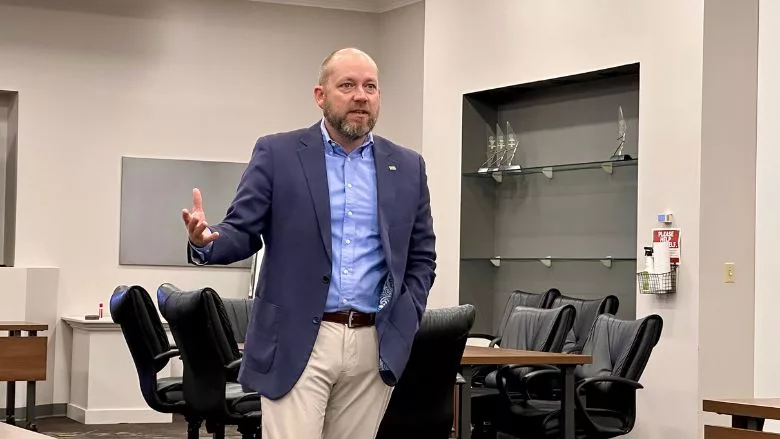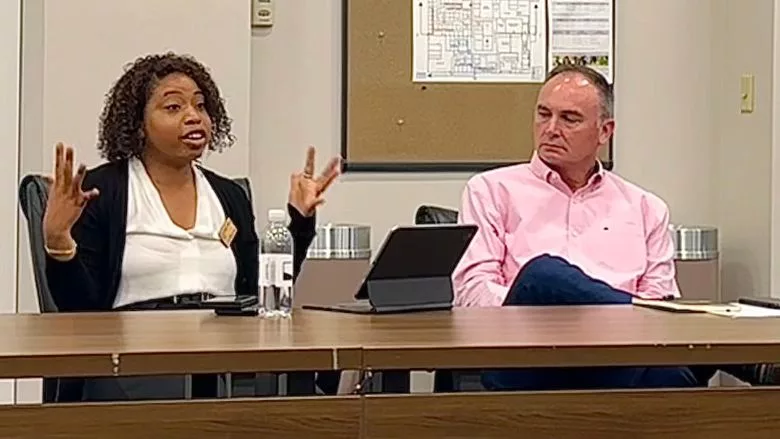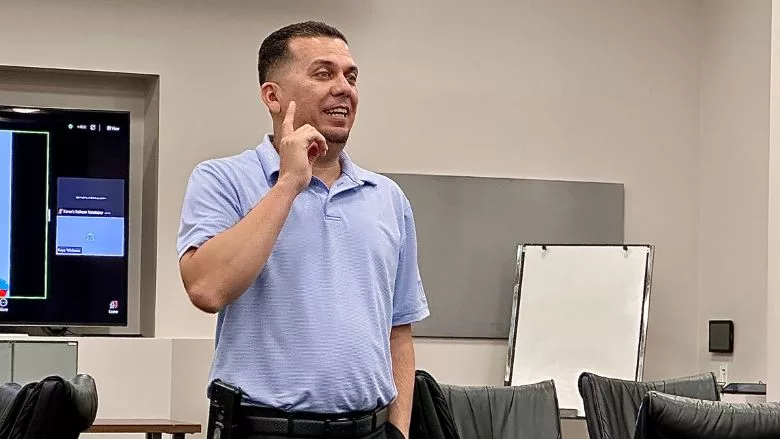Floor Covering Education Foundation Makes Strides in Addressing Installation Labor Crisis
Industry's Bold Plan Yields Results: Jobs Waiting For New Installers

“The more we can connect the education and jobs together, we can close this gap," said Bo Drake, VP of economic and workforce development, Chattanooga State Community College. Photo: Floor Trends & Installation.

Andrea Wiggins, a representative from the office of Sen. Raphael Warnock (D-GA), and Russell Headrick, director of financial services at Shaw Industries, at the May 16 Floor Covering Education Foundation board meeting in Dalton, Georgia. Photo: Floor Trends & Installation.

Chattanooga State Community College shared a student success story from the FCEF Basic Floor Covering Installation Program. From left: Instructor Pablo Barbosa; graduate John Schenck; Cynthia Brooks, business and community development manager; and Bo Drake, VP of economic and workforce development. Photo: Floor Trends & Installation.

FCEF Basic Flooring Installation course instructor Pablo Barbosa speaks about the program's impact at the FCEF board meeting on May 16, 2025, in Dalton, Georgia. Photo: Floor Trends & Installation.
In a conference room at Shaw Industries Design Center in Dalton, Georgia, a young man named John Schenck meets with some of the flooring industry's most influential leaders. Just days after completing his installation training program, he's already fielding multiple apprenticeship offers — exactly the outcome the Floor Covering Education Foundation (FCEF) envisioned when it launched its ambitious initiative to address a critical installer shortage threatening the industry's future.
"This is changing lives," remarked FCEF Executive Director Kaye Whitener during the foundation's board meeting on May 16, where stories like Schenck's took center stage. What began with two pilot programs in 2022 has developed into 26 colleges across 16 states and two countries, with an audacious goal to expand to 200 technical colleges and high schools within five years.
The foundation, created in 2019 in response to the Blackstone report showing a deficit of 46,000 installers annually with an average installer age of 56, is now seeing tangible results from its early investments in education and training.
"We would like to, in five years, be in 200 technical colleges and high schools," Whitener shared with the board, emphasizing their ambitious growth targets. "That's the hard work that this team has done and what our industry has benefited from."
Program Impact and Graduate Success Stories
Board members heard directly from Chattanooga State Community College representatives, including Bo Drake, VP economic and workforce development; Cynthia Brooks, business and community development manager; and instructor Pablo Barbosa.
This first-hand testimony provided compelling evidence of the program's effectiveness in creating viable career paths.
“The more we can connect the education and jobs together, we can close this gap," Drake said.
"They're not just labor. They're also buyers of the product," noted one board member, highlighting the dual benefit of training new installers for the industry.
Schenck, who recently completed all four FCEF program modules (resilient, hardwood, carpet, and ceramic tile), shared his journey and already has two apprenticeship opportunities lined up. "I never had any prior experience," he said.
The board also received updates on William Rivera, FCEF's first scholarship recipient from Cincinnati, who completed training in 2022 and is now thriving in commercial installation, managing a crew of 43 installers.
Another success story featured Charity Adeoti, a graduate from Hawkeye Community College in Waterloo, Iowa, who found her passion for tile installation and has since earned two additional certifications from CFI in carpet installation.
Listen to the podcast: Charity Adeoti: The Next Generation of Flooring Installer
Program Growth and Measurable Results
The foundation reported that as of the meeting date, they had awarded 134 scholarships in 2025 and 435 scholarships since the program's inception. Additionally, 188 people completed training without requiring scholarships, using alternative funding sources such as Pell Grants or high school programs. The group has trained a total of 623 students. Importantly, 82% of program graduates are now working in the flooring industry.
The curriculum offers substantial support to participating schools, including free curriculum materials, instructor support, marketing templates, tool and material donations, and job placement assistance. The foundation has also established an industry-recognized credential through CFI for carpet, hardwood, and resilient flooring installation.
The program's flexibility has been key to its adoption. "It can be manipulated to the best fit of the college. It is not a restrictive curriculum," Whitener explained, noting that the four disciplines can be broken into two-week segments if that's what colleges require.
The meeting also addressed ongoing industry challenges, with board members discussing how the current labor shortage is impacting business. Many noted that the foundation's work is critical, as U.S. Department of Labor and Bureau of Statistics data shows 9,600 annual job openings in the sector.
One retailer described how they've seen installation businesses fail when skilled installers lack business acumen: "What we run into is turnover with installers that have the skills, but they have no idea how to operate a business." This sparked discussion about incorporating more business training into the curriculum.
New Initiatives and Future Direction
The foundation announced it has been approved as a Department of Defense industry partner for the Skill Bridge program, which allows military personnel within 180 days of discharge to receive training while still being paid by the military. "This gives us an opportunity because one of our biggest challenges is recruiting," Whitener noted, adding that approximately 200,000 people exit the military each year who could now access FCEF programs.
Board members, led by chairperson Deb DeGraaf (co-owner of DeGraaf Interiors) and co-chair Dave Chambers (director of flooring at Nebraska Furniture Mart), discussed potential new revenue streams and ways to create more value for industry donors.
Several board members suggested creating a membership model where flooring retailers who financially support the foundation would get exclusive first access to program graduates. "If you're going to benefit from this foundation, you need to be a contributor," one board member emphasized.
The board also discussed enhancing recruitment through better storytelling and marketing, with suggestions to create more video content featuring graduates like John to showcase the program's impact.
Leveraging Government Relations to Support FCEF Initiatives
Andrea Wiggins, a representative from the office of Sen. Raphael Warnock (D-GA), who has been working with FCEF for three years, shared crucial insights about maximizing congressional support for the foundation's work:
-
Congressional engagement: She emphasized that every board member should ensure their congressional delegation knows about FCEF's work. She advised contacting congressional offices directly and asking for outreach staff.
-
Letters of support for grants: Congressional offices can write letters of support for grant applications, which significantly strengthen applications by demonstrating community commitment and broad political backing.
-
Congressional Directive Spending: She highlighted this funding mechanism that allows members of Congress to allocate direct funds for specific projects. While these funds cannot cover staffing or land acquisitions, they can support equipment purchases like training simulators and mobile training units.
-
Bipartisan advantage: She noted that FCEF's representation across diverse states gives them a strategic advantage in working with both Republicans and Democrats. "We, as a Georgia delegation, if it's a Georgia matter, we don't care what the politics are in D.C. If it's Georgia, we line and focus," Wiggins explained.
-
State and local funding opportunities: Wiggins recommended engaging with state legislatures, emphasizing that "state money moves a whole lot faster than federal." She also suggested approaching county commissioners for pilot program funding.
- Programmatic spending: Beyond one-time funding, Wiggins advised FCEF to pursue programmatic spending, which allows for the creation of federal language that can have longer-term impacts rather than just one-time financial support.
As the meeting concluded, the board expressed optimism about the foundation's trajectory while acknowledging the significant work still ahead to fully address the industry's labor shortage. With growing college partnerships, proven success stories, and new initiatives like the military Skill Bridge program, FCEF continues to build momentum in its mission to recruit and train the next generation of flooring installers.
Looking for a reprint of this article?
From high-res PDFs to custom plaques, order your copy today!

.webp?height=200&t=1714489808&width=200)




